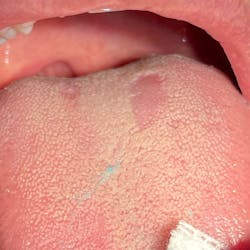One in three smiles has unique quirks: missing teeth, odd shapes, or misplaced grins. From subtle twists to dramatic gaps, these dental oddities come in two flavors: number and structure.1
Identifying number anomalies
The three commonly encountered number anomalies are hypodontia, hyperdontia, and retained primary teeth.
Hypodontia is used as an umbrella term, encompassing all cases of missing teeth (excluding third molars), whereas agenesis occurs when teeth never form or erupt (including third molars) and oligodontia refers to six or more missing permanent teeth (excluding third molars).
These anomalies affect one in 10 individuals.2 Genetics and environment, including ethnicity and regional differences, likely influence the specific teeth affected.3 Research points to a potentially lower rate of occurrence among African Americans compared to Caucasians,4 while studies in China and Italy have identified missing mandibular incisors or mandibular second premolars as most prevalent.5
Hyperdontia (supernumerary teeth) refers to having more than the normal number of teeth foreseen in primary or permanent dentition. Hyperdontia affects between 0.8% and 3.8% of the global population, is more frequent in males than females,6 and has a predisposition for the upper maxillary incisor and the mandibular premolar area.7 While specific genes haven’t been identified, familial patterns and population differences hint at the potential involvement of multiple genes and their interactions with environmental factors. It is important to note that some syndromes have higher rates of multiple supernumerary teeth, but not all cases with multiple teeth are syndromic.8
Number: The teeth could be solitary (usually in the upper incisor or lower premolar areas) or multiple.
Location: They are known as mesiodens (between the central and lateral incisors), paramolars (beside the premolars), or distomolars (distal to third molars).
Morphology: Their morphology can vary widely, with a conical shape (smaller and simpler than their regular counterparts), tuberculate, and odontoma (a cluster of small, irregular teeth fused together).
When baby teeth don’t shed as expected, it creates another deviation known as retained primary teeth. This can lead to crowding, misaligned permanent teeth, and gum disease, and other issues. Although some cases may have minimal impact, intervention is often necessary to ensure a healthy dental development.9
You may also be interested in ... Gallery: Expert insights into clinical anomalies
Structural deviations in dental anomalies
Structural deviations also play a significant role in these anomalies, impacting both the appearance and function of the teeth.10 To understand the deviations, we must first understand the tooth’s development process and how the complex interplay of genes and environmental factors might affect the dental structure.
Stage 1: Initiation. Epithelial-mesenchymal interactions triggered by signaling molecules orchestrate the formation of the primordial dental lamina, laying the foundation for the dental buds.
- Dental anomaly associated with this stage: anodontia
Stage 2: Histodifferentiation. Within the bud’s tooth germ, cellular differentiation takes place. Ectodermal cells transform into enamel-producing ameloblasts, mesenchymal cells morph into dentin-forming odontoblasts, and the remaining mesenchyme condenses to form the tooth’s pulp.
- Dental anomalies associated with this stage: gemination, fused roots, amelogenesis imperfecta, and dentinogenesis imperfecta
Stage 3: Morphogenesis. The dental papilla initiates crown formation, and the dental lamina shapes the external contours. Meanwhile, the epithelial root sheath develops the root.
- Dental anomalies associated with this stage: dilaceration and dens evaginatus
Stage 4: Mineralization. The enamel and the dentin harden.
- Dental anomalies associated with this stage: enamel hypoplasia and taurodontism
Stage 5: Eruption. Structural deviations emerge when various disruptions occur during the eruption process. These deviations can stem from faulty genes that disrupt signaling pathways, affecting cell differentiation and enamel/dentin formation,11 nutritional deficiencies, infections, trauma, and even certain medications during tooth development and syndromic associations such as amelogenesis imperfecta.
Unveiling the enamel and dentin enigma
Enamel hypoplasia (EH) is the most commonly reported dental anomaly.12 Defined as the enamel thinning caused by partial or complete inhibition of ameloblast function during the secretory phase of enamel formation,13 EH manifests as pits, grooves, or discoloration in the enamel. A lack of calcium and phosphorus during tooth development, infections that disrupt the process of enamel production, trauma to the developing tooth, and certain genetic conditions can predispose individuals to hypoplastic teeth. EH affects one in five kids, especially those facing malnutrition and sanitation issues. Baby teeth get it worse, particularly mandibular canines and maxillary central incisors. Still, the issue eases up as permanent teeth arrive.14
Amelogenesis imperfecta (AI) represents a spectrum of inherited disorders characterized by defective enamel formation due to genetic mutations. This disruption causes a diverse array of enamel phenotypes. Clinically, the enamel might be thin and fragile (hypoplastic), poorly mineralized (hypomineralized), or a combination of both.15 This results in discolored, sensitive teeth that are prone to chipping or breaking. AI can appear on its own or be part of a broader syndrome with other associated symptoms.16
Dentinogenesis imperfecta (DI) is a genetic disorder characterized by severe hypomineralization and structural anomalies of the dentin in both the primary and secondary dentition.17 Mutations in the sialophosphoprotein gene (DSPP)18 disrupt the protein production, leading to severe hypomineralization, causing weaker, fragile dentin in a tooth with a characteristic bluish-gray or yellow-brown discoloration from altered dentin structure.
Shape and size variations
Microdontia often comes with a class III malocclusion. Shared causes such as genetic syndromes or pituitary hormone deficiencies may stunt tooth growth and jaw alignment.19 Shafer et al.20 classified microdontia into three distinct categories:
- Single-tooth microdontia: most commonly the maxillary lateral incisor or third molars
- Relative generalized microdontia: presents with small teeth in relatively large jaws
- True generalized microdontia: most severe form involving a reduction in the size of all teeth within the dentition
Macrodontia describes abnormally large teeth and affects between 0.03% and 1.9% of the population.21 While significantly less common than its counterpart, it can manifest in various forms:
- True generalized macrodontia: often associated with pituitary gigantism,22 where all teeth exceed normal size
- Relative generalized macrodontia: teeth of normal or slightly larger size erupting in a proportionally smaller jaw
- Macrodontia of a single tooth: an isolated tooth exhibiting abnormal enlargement, potentially due to gemination
Shape matters
Even though dens evaginatus (DE) and talon cusp (TC) share an etiology that involves disruptions in enamel development, causing an evagination on the surface of a tooth crown before calcification has occurred23 and resulting in an extra cusp, they subtly differ. DE can be found on any tooth as a bump or tubercle that can be tiny or might reach the incisal/occlusal border. TC, exclusively seen on front teeth, is larger, pointed, and often overlaps the border.24 Both anomalies require good oral hygiene and potential restorative treatment depending on size and complications.
Root and crown morphology
Gemination manifests as an incomplete attempt of a single tooth bud to bifurcate, resulting in a tooth with two partially or completely separated crowns and a single root.25 It might have a bifid crown that exhibits varying degrees of separation, ranging from subtle grooves to distinct clefts and presenting as two fused teeth but retaining their individuality with a unitary root structure harboring one or two root canals within.
Fused roots emerge from the complete coalescence of two separate tooth buds during development, leading to a single crown with two or more fused roots. Fused roots often manifest as a depression within the root surface that can become a nidus for bacterial colonization due to impaired adhesion of the junctional epithelium, forming a potential pathway for microbial invasion and subsequent bone resorption.26
Taurodontism is a change in the tooth’s shape that affects both primary and permanent teeth. It is caused by the failure of Hertwig’s epithelial sheath diaphragm to invaginate at the proper horizontal level,27 resulting in an enlarged pulp chamber and shortened roots relative to the crown’s size. Taurodontism can be an isolated anomaly or associated with various syndromes, such as Down syndrome and cleidocranial dysplasia. These are the three classifications of taurodontism:
- Mild: subtle enlargement of the pulp chamber with minimal root shortening
- Moderate: more pronounced enlargement, extending halfway into the root
- Severe: significant increase in pulp chamber size with shortened roots
Internal structural deviations
Dens in dente arises from an infolding of the enamel organ during tooth development, leading to the formation of an additional, often cone-shaped, structure within the dentin. Varying in complexity, dens in dente can be simple invaginations (grooves), evaginations (protrusions), or complex structures with a distinct crown and even a miniaturized root canal. Maxillary lateral incisors are the most common teeth affected by this dental anomaly.28
Histological analysis demonstrates a thin layer of enamel and dentin separating the invagination from the pulpal tissue. This hypoplastic barrier can compromise its protective function, initiating a cascade of events leading to pulpal necrosis and infection.29
Dilaceration is an abnormal bending or angulation of the tooth’s root that affects 1%–3% of the population. It is more common in males than in females and can occur in any tooth but more frequently in incisors and canines.30,31 Causes include trauma to the tooth bud during development, genetic disorders, infection, and poor nutrition.
Dilaceration can be classified depending on:
- Angle of angulation (mild, moderate, or severe)
- Location of the dilaceration
- Number of roots affected (it can affect one or more roots)
Patients with root dilaceration may be asymptomatic or may experience a variety of symptoms, including delayed eruption of the tooth, prolonged retention of the deciduous tooth, crowding, or malposition.
Treatment depends on the severity of the dilaceration and the symptoms the patient is experiencing. In some cases, no treatment is necessary.
Not merely cosmetic concerns
No matter which dental anomaly we are referring to, it isn’t merely a cosmetic concern. Dental anomalies can set the stage for a cascade of issues such as increased cavity risk, enhanced plaque retention, and accelerated tooth wear.
Editor's note: This article appeared in the March 2024 print edition of RDH magazine. Dental hygienists in North America are eligible for a complimentary print subscription. Sign up here.
References
- Tunis TS, Sarne O, Hershkovitz I, et al. Dental anomalies’ characteristics. Diagnostics (Basel). 2021;11(7):1161. doi:10.3390/diagnostics11071161
- Eshgian N, Al-Talib T, Nelson S, Abubakr NH. Prevalence of hyperdontia, hypodontia, and concomitant hypo-hyperdontia. J Dent Sci. 2021;16(2):713-717. doi:10.1016/j.jds.2020.09.005
- Gracco ALT, Zanatta S, Valvecchi FF, Bignotti D, Perri A, Baciliero F. Prevalence of dental agenesis in a sample of Italian orthodontic patients: an epidemiological study. Prog Orthod. 2017;18(1):33. doi:10.1186/s40510-017-0186-9
- Harris EF, Clark LL. An epidemiological study of hyperdontia in American blacks and whites. Angle Orthod. 2008;78(3):460-465. doi:10.2319/022807-104.1
- Davis PJ. Hypodontia and hyperdontia of permanent teeth in Hong Kong schoolchildren. Community Dent Oral Epidemiol. 1987;15(4):218-220. doi:10.1111/j.1600-0528.1987.tb00524.x
- Cammarata-Scalisi F, Avendaño A, Callea M. Main genetic entities associated with supernumerary teeth. Arch Argent Pediatr. 2018;116(6):437-444. doi:10.5546/aap.2018.eng.437
- Garvey MT, Barry HJ, Blake M. Supernumerary teeth—an overview of classification, diagnosis and management. J Can Dent Assoc. 1999;65(11):612-616.
- Suljkanovic N, Balic D, Begic N. Supernumerary and supplementary teeth in a non-syndromic patients. Med Arch. 2021;75(1):78-81. doi:10.5455/medarh.2021.75.78-81
- Aldowsari M, Alsaif FS, Alhussain MS, et al. Prevalence of delayed eruption of permanent upper central incisors at a tertiary hospital in Riyadh, Saudi Arabia. Children (Basel). 2022;9(11):1781. doi:10.3390/children9111781
- Şen Yavuz B, Sezer B, Kaya R, Tuğcu N, Kargül B. Is there an association between molar incisor hypomineralization and developmental dental anomalies? A case-control study. BMC Oral Health. 2023;23(1):776. doi:10.1186/s12903-023-03540-8
- Seow WK. Developmental defects of enamel and dentine: challenges for basic science research and clinical management. Aust Dent J. 2014;59(Suppl 1):143-154. doi:10.1111/adj.12104
- Tejani Z, Batra P, Mason C, Atherton D. Focal dermal hypoplasia: oral and dental findings. J Clin Pediatr Dent. 2005;30(1):67-72. doi:10.17796/jcpd.30.1.q737147154231251
- Dąbrowski P, Kulus MJ, Furmanek M, Paulsen F, Grzelak J, Domagała Z. Estimation of age at onset of linear enamel hypoplasia. New calculation tool, description and comparison of current methods. J Anat. 2021;239(4):920-931. doi:10.1111/joa.13462
- Mukhopadhyay S, Roy P, Mandal B, Ghosh C, Chakraborty B. Enamel hypoplasia of primary canine: its prevalence and degree of expression. J Nat Sci Biol Med. 2014;5(1):43-46. doi:10.4103/0976-9668.127283
- Crawford PJM, Aldred M, Bloch-Zupan A. Amelogenesis imperfecta. Orphanet J Rare Dis. 2007;2:17. doi:10.1186/1750-1172-2-17
- Smith CEL, Poulter JA, Antanaviciute A, et al. Amelogenesis imperfecta; genes, proteins, and pathways. Front Physiol. 2017;8:435. doi:10.3389/fphys.2017.00435
- Barron MJ, McDonnell ST, Mackie I, Dixon MJ. Hereditary dentine disorders: dentinogenesis imperfecta and dentine dysplasia. Orphanet J Rare Dis. 2008;3:31. doi:10.1186/1750-1172-3-31
- de La Dure-Molla M, Fournier BP, Berdal A. Isolated dentinogenesis imperfecta and dentin dysplasia: revision of the classification. Eur J Hum Genet. 2015;23(4):445-451. doi:10.1038/ejhg.2014.159
- Fernandez CCA, Pereira CVCA, Luiz RR, Vieira AR, De Castro Costa M. Dental anomalies in different growth and skeletal malocclusion patterns. Angle Orthod. 2018;88(2):195-201. doi:10.2319/071917-482.1
- Shafer WG, Hine MK, Levy BM. A Textbook of Oral Pathology. W. B. Saunders Co.; 1958:26.
- Canoglu E, Canoglu H, Aktas A, Cehreli ZC. Isolated bilateral macrodontia of mandibular second premolars: a case report. Eur J Dent. 2012;6(3):330-334.
- Chetty M, Beshtawi K, Roomaney I, Kabbashi S. Macrodontia: a brief overview and a case report of KBG syndrome. Radiol Case Rep. 2021;16(6):1305-1310. doi:10.1016/j.radcr.2021.02.068
- Sachdeva SK, Verma P, Dutta S, Verma KG. Facial talon cusp on mandibular incisor: a rare case report with review of literature. Indian J Dent Res. 2014;25(3):398-400. doi:10.4103/0970-9290.138355
- Elmubarak NAR. Genetic risk of talon cusp: talon cusp in five siblings. Case Rep Dent. 2019;2019:3080769. doi:10.1155/2019/3080769
- Mohan RPS, Verma S, Singh U, Agarwal N. Gemination. BMJ Case Rep. 2013;2013:bcr2013010277. doi:10.1136/bcr-2013-010277
- Marcano-Caldera M, Mejia-Cardona JL, Blanco-Uribe MDP, Chaverra-Mesa EC, Rodríguez-Lezama D, Parra-Sánchez JH. Fused roots of maxillary molars: characterization and prevalence in a Latin American sub-population: a cone beam computed tomography study. Restor Dent Endod. 2019;44(2):e16. doi:10.5395/rde.2019.44.e16
- Dineshshankar J, Sivakumar M, Balasubramanium AM, Kesavan G, Karthikeyan M, Prasad VS. Taurodontism. J Pharm Bioallied Sci. 2014;6(Suppl 1):S13-S15. doi:10.4103/0975-7406.137252
- Mehta V, Raheja A, Singh RK. Management of dens in dente associated with a chronic periapical lesion. BMJ Case Rep. 2015;2015:bcr2015211219. doi:10.1136/bcr-2015-211219
- Hegde V, Morawala A, Gupta A, Khandwawala N. Dens in dente: a minimally invasive nonsurgical approach! J Conserv Dent. 2016;19(5):487-489. doi:10.4103/0972-0707.190014
- Sahebi S, Razavian A, Maddahi N, Asheghi B, Booshehri MZ. Evaluation of root dilaceration in permanent anterior and canine teeth in the southern subpopulation of Iran using cone-beam computed tomography. J Dent (Shiraz). 2023;24(3):320-327. doi:10.30476/dentjods.2022.95451
- Qutieshat A, Al Harthy N, Javanmardi S, et al. Prevalence of mesio-distal dilaceration in patients presenting for initial orthodontic care: a retrospective study. J Orthod Sci. 2023;12:13. doi:10.4103/jos.jos_75_22
Andreina Sucre, MS, RDH, is an oral pathology and oral surgery specialist, and a practicing dental hygienist in South Florida. She’s a speaker, writer, and advocate for early pathological diagnosis. Andreina was born in Venezuela where she earned her dental degree in 2002 from Universidad Santa Maria. In December 2005, she earned her certificate and specialization degree in oral pathology and oral surgery from Pontificia Universidad Javeriana, in Colombia. Follow her on Instagram @thepathordh.








